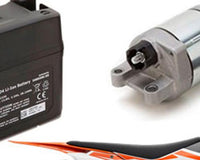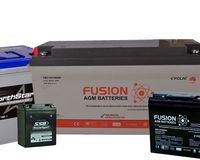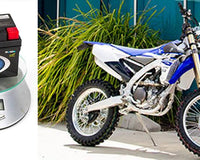Table of Contents
There are a few factors you need to consider to select the best battery for your truck or car—one of them being battery ratings.
Understanding battery ratings and how they relate to your battery's operating conditions can help you select one with the right amount of power for your vehicle.
Before you purchase a battery, you may need to know its size, amps hours (AH), RC (reserve capacity), and cold cranking amps (CRA) ratings. Most of these specifications are usually indicated on the battery’s sticker or label and conform to the Battery Council International’s (BCI) guidelines.
Today, we'll look at CCA battery ratings and why they're essential for those who live in extreme climates.
What Is a CCA Battery Rating?
Cold Cranking Amps (CCA) is a rating used in the automotive industry to determine how well a battery can perform in cold temperatures.
This rating tells you how many amps a given 12-volts battery may support for 30 seconds at 0°F (-18°C) before the voltage drops to at least 7.2 volts over the battery.
Batteries perform differently in different temperatures. As such, understanding the CCA rating for your battery is essential, especially if you reside in a cold region.
Cold temperatures affect battery fluids by slowing down chemical reactions within the battery. This results in a weaker electric current.
Moreover, low temperatures thicken engine oil, making it difficult to pump the fluid through the engine block. In the case of diesel engines, such temperatures cause the diesel fuel to gel.
Since CCA estimates the range and lifetime at lower temperatures, most people use it to determine whether it’s good or bad for particular purposes.
For instance, some vehicle components, such as air conditioning, radio, and clocks, use electrical power from the batteries. Therefore, if a battery has a good CCA rating, it can support other vehicle accessories.
A low CCA rating indicates that the battery doesn’t hold enough power to turn on headlights or start the engine.
An ideal battery for a small car should have a rating of at least 150 CCAs, while high-performance vehicles should have a rating of around 500 CCAs. In general, assessing CCA will indicate how your battery would perform in worst-case scenarios.
The table below shows how battery power diminishes as temperatures drop, requiring greater cranking power to start an engine.
| Power Supplied | Temperature | Power Required |
| 100% (0% Drop) | 80 Degrees F | Normal Power |
| 65% (35% Drop) | 32 Degrees F | 150% More Power |
| 40% (60% Drop) | 0 Degrees F | 210% More Power |
| 25% (75% Drop) | -20 Degrees F | 350% More Power |
Cold Cranking Amps Vs. Cranking Amps (CA)
Although used at different temperatures, Cold Cranking Amps (CA) and Cranking Amps (CCA) measure how much power a battery outputs.
Cranking Amps (CA) is calculated by measuring the current flowing from the battery while held at 0°C or 32°F. Put simply, cranking amps is the amount of current (power) your vehicle’s engine requires to start in normal or marine environments.
CCA measures how much power a 12-volts battery requires to turn on a vehicle engine at 0 °F(-18°C) for about 30 seconds without falling below 7.2 volts. As a result, CCAs are better suited to low temperature settings.
Typically, CAs are quoted as a means of quantifying the useful life of a battery in mild temperatures (between 64°F and 86°F). However, they don’t predict how well a battery can perform under extreme conditions, such as hot or cold temperatures.
CCA provides an accurate estimate of a battery’s remaining useful life. Therefore, it provides a means of determining how well a battery will perform under different temperatures.
Apart from the behaviour of batteries varying drastically due to climatic conditions, they also become chemically degraded when exposed to heat, overcharging, or repeated deep discharge.

Calculating Amp Hours in a CCA Battery
As the complexity of modern automobiles grows, so does the demand for better battery performance.
Due to this, knowing how many amp-hours a battery has is crucial when purchasing one. You can easily calculate this using a car battery’s CCA values.
Amp-hours refer to the amount of energy charge a battery can output in one hour.
Below are some formulas you can use to calculate amp-hours in CCA batteries.
You can get the Ah value by dividing CCA by 7.25 using CCA/7.25 = Ah.
Therefore, if you have a 725 CCA battery rating, converting it into Ah will give you 100 Amp-hours. This means that your battery can last up to 10 hours with ten amps of voltage.
You can also calculate the Ah value by multiplying the CCA value given by 0.7. Let’s say your CCA value is 300, and you multiply that by 0.7, your Ah value will be 210.
With these formulas, you can calculate both Ah and CCA ratings. This allows you to select an appropriate battery for your vehicle’s powertrain in cold regions.
The CCA Battery Rating That a Vehicle Needs to Start
According to today’s automotive industry standards, it’s crucial for a battery to have at least one CCA for each cubic inch engine displacement and at least two for diesel engines. The manufacturers usually provide the CCA requirement for each model and engine.
However, the amount of cranking current required to start an automobile battery depends on factors, including:
- Engine size
- The resistance of your circuits
- Climate
- Engine oil viscosity
For example, starting accessories may have different resistances and require different amounts of cranking current.
If you have a four-cylinder vehicle, you may not require the same cranking current as an eight-cylinder vehicle. The higher the cylinder count, the more CCA is required to provide the vehicle with its required power.
Even if you want your vehicle to start a little faster, you don't need a battery with a higher CCA if you live in a marine or warmer region. That's because your vehicle's delayed start could be caused by something other than temperature.
Extra Tip: When replacing or purchasing a new battery, ensure it meets or exceeds the original battery's specifications.
Frequently Asked Questions
What is considered a good CCA rating for a battery?
Generally, batteries with the highest CCA rating possible are the best. That’s because they have a better overall capacity and ability to withstand extreme weather conditions.
When buying a replacement battery for your vehicle, choose one with a rating of 650 CCAs or more. However, it’s worth noting that batteries with a high CCA rating will be more expensive.
If your battery happens to have a low CCA, it’s likely to fail in cold conditions since it might not be capable of delivering enough current to start the engine.
Some other problems that might arise due to low CCA rating include:
- Dim headlights
- Rapid clicking noise
- Windshield wiper system failure
- Air conditioning problems
Is it okay to put a higher CCA battery in my car?
Yes, it’s okay to put a battery with a higher CCA rating in your car. However, this is only recommended for colder climates, as higher CCA batteries are more susceptible to leakage and failure in hotter areas.
You also have to keep in mind that a battery with a higher CCA rating can sometimes be large and not fit in your car’s battery tray.

Will a higher CCA battery last longer?
A higher CCA rating battery may be more dependable and potentially live longer. Moreover, it doesn’t require you to replace it from time to time.
However, the battery's longevity is determined by its materials. For example, batteries with strengthened plates and a high lead content are more likely to live longer than those intended for maximum cranking performance.
If you’re having trouble deciding which batteries are suitable for your vehicle, HBPlus Battery Specialists has a large assortment of batteries for different applications and conditions.









